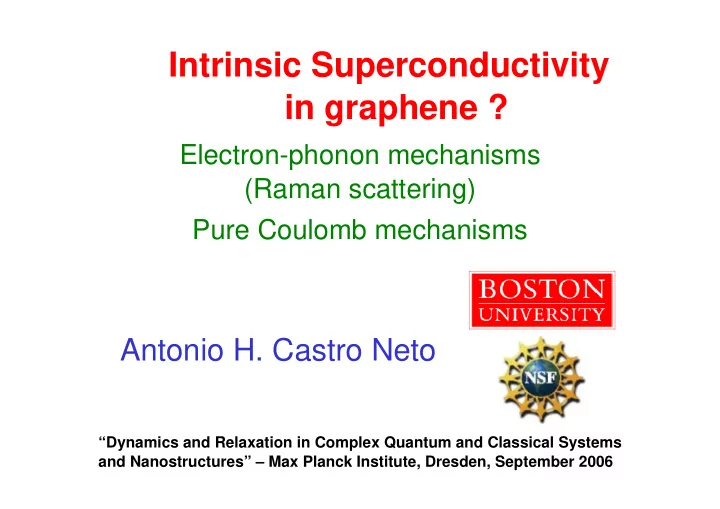

Intrinsic Superconductivity in graphene ? Electron-phonon mechanisms (Raman scattering) Pure Coulomb mechanisms Antonio H. Castro Neto “Dynamics and Relaxation in Complex Quantum and Classical Systems and Nanostructures” – Max Planck Institute, Dresden, September 2006
0Å 9Å 13Å Collaborators: Francisco Guinea (ICMM, Spain) Johan Nilsson (BU, USA) Vitor Pereira (Univ. Porto, Portugal) Nuno Peres (Univ. Minho, Portugal) 1 µm Bruno Uchoa (BU, USA) Novoselov et al, Science 306, 666 (2004) Joao L. dos Santos (Univ. Porto, Portugal) cond-mat/0608543 cond-mat/0608515 cond-mat/0607343 Phys. Rev. B 73, 245426 (2006) cond-mat/0604106 Phys. Rev. B 73, 241403 (2006) Phys. Rev. B 73, 195411 (2006) Phys. Rev. B 73, 214418 (2006) Phys. Rev. B 73, 125411 (2006) Phys. Rev. Lett. 96, 036801 (2006) Phys. Rev. B 72, 174406 (2005) Annals of Physics 321, 1559 (2006).
A Personal Note Free non-relativistic electrons in a box = NO LATTICE 2 p = H 2 m Felix Ignorance is dumped here ! Bloch Paul Drude Arnold Sommerfeld NO INTERACTIONS Lev Landau
Novoselov et al, Science 306, 666 (2004) ⎛ ⎞ ϕ i ( p ) 0 e ⎜ ⎟ = H vp ⎜ ⎟ − ϕ i ( p ) ⎝ ⎠ Paul e 0 Dirac Free relativisitic electrons in a box DISORDER INTERACTIONS Ignorance is dumped here !
What would be the effective theory for superconductivity in graphene ? Metal is traced out A p+ip wave s-wave Ψ = ψ ⊗ ψ ⊗ ψ = = − S 0 L 1 A B
Mean field phenomenology
Dirac Fermion pairing AHCN, Phys. Rev. Lett. 86, 4382 (2001) B.Uchoa, AHCN, G. Cabrera, Phys.Rev.B 69, 144512 (2004) B.Uchoa, G. Cabrera, AHCN, Phys.Rev.B 71, 184509 (2005)
The quantum theory is critical
Phase diagram s-wave phase E first order
Electron-phonon coupling 2 ⎛ ⎞ dt N ( E ) λ = ⎜ ⎟ 2 F x ω ⎝ ⎠ dl 0 1 ∝ Weak coupling N ( E ) 2 D F W E E ∝ ∝ F F N ( E ) g F 2 2 2 v / a W F
K’ Q K
Metal coated graphene A proposal
The idea: start with the non-interacting problem A
2 Band superconductivity in graphene And add Coulomb interactions plane distance d All interactions are repulsive !
Graphene Effective Interaction (RPA) The interaction can be strongly attractive close to the zeros of the dielectric function plasmon where electrons resonate with plasmons !
2D Coulomb interaction 2 Band superconductivity in graphene Dielectric function where
2DEG acoustic plasmon screened acoustic plasmon 1 2
2DEG plasmon
screened acoustic plasmon
The screened mode will exist if it is not overdamped by the electronic particle-hole continuum: If x is the fraction of electrons per metallic atom that migrates to graphene in the compound, C m A n this condition is equivalent to for a pocket of a few eV. Superconductivity is favored for a sufficiently diluted coverage of the metal (large n) !
Carbon Superconductivity Fullerenes C 60 is an insulator but C 60 K 3 is a superconductor (18 K) C 60 buckyball Hebard et al. , Nature 352, 223 (1991) but C 60 K 4 is an insulator indicating that superconductivity happens with metal dilution
Intercalated Graphite C 2 Li (1.9 K) C 8 K (0.5 K) C 6 Ca (11.5 K) C 6 Yb (6.5 K)
Graphite intercalated compounds (GIC ) Yb Graphite NFEB Czanyi et al. , Nat. Phys. 1, 42 (2005)
Graphite Graphite intercalated compounds (GIC ) NFEB Yb 3D NFEB C 6 Yb
Graphite intercalated compounds (GIC ) C 6 Ca NFEB 3D NFEB Fermi surface Mazin et al. , cond-mat/0606404
Yes Yes Graphite intercalated compounds (GIC ) No No No No NFEB FS? SC?
Graphite intercalated compounds (GIC ) Czanyi et al. , Nat. Phys. 1, 42 (2005) 2 band model model superconductivity?
Conclusions We showed that superconductivity is possible in graphene using a purely electronic mechanism A reliable estimation of T c requires the inclusion of retardation in the interaction (strong coupling theory) Graphene has has a new superconducting phase with p+ip wave pairing in the singlet channel.
Recommend
More recommend